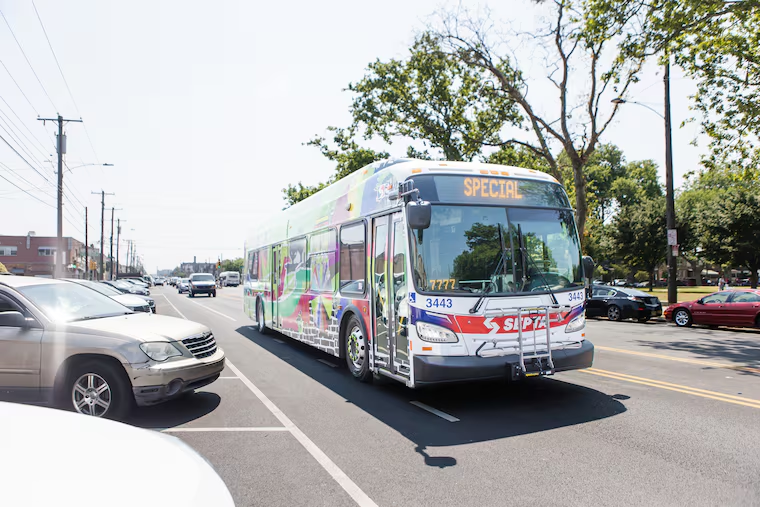SEPTA bus overhaul will not exacerbate inequalities, new study says, despite critics’ concerns
The study measured the number of jobs a rider could reach within 30 and 45 minutes and average travel times to the nearest hospital, rec center, library, and closest supermarkets.

A new independent analysis of SEPTA’s bus network overhaul contradicts a major concern raised by critics of the project: that proposed service changes would reinforce transportation inequities.
The latest complete version of SEPTA’s bus network overhaul, a plan developed over the last three years, would deliver increased access to opportunity or preserve existing levels of access for most Philadelphia riders compared with current routes, according to an equity analysis by the nonprofit TransitCenter think tank.
Overall, the study found that the December 2023 draft of the Bus Revolution would result in minor changes, up or down, in the numbers of jobs, hospitals, libraries, rec centers and supermarkets that riders could reach and travel times needed to get there.
“The way I read it, Bus Revolution is neither as bad as anyone fears nor as good as some people would like it to be,” said Connor Descheemaker, coalition manager for the nonprofit advocacy group Transit Forward Philadelphia.
And SEPTA planners were constrained by a mandate to keep the route reorganization cost-neutral, meaning that every boost in bus service in one area had to be balanced by a cut somewhere else, a kind of mathematical taffy pull.
“The only way to more substantively improve access is to invest money on more service hours,” Descheemaker said.
Access to hospitals, groceries, and rec centers
New York-based TransitCenter conducted the equity comparison analysis of the December 2023 Bus Revolution plan and the current network for Transit Forward Philadelphia.
The researchers used several periods throughout the week to show differences and similarities.
They found average travel times to the nearest hospital, rec center, library, and three supermarkets fell within one minute of current times for all demographics measured in both the proposed and current network.
The analysis also measured the number of jobs a rider could reach within 30 and 45 minutes of their starting point at different times in each network.
It found some improvements in access to jobs under the Bus Revolution Plan, including:
Asian residents would be able to reach more jobs within 30 minutes on weekday afternoons and evenings than today.
The number of jobs accessible within 30 minutes on weekday mornings increased across all demographics. Notably, one of the biggest improvements was for households without access to a car.
Black residents would see an increase number of jobs accessible within 45 minutes on weekend afternoons.
Outcomes were broken out for white, Black, Asian and Hispanic people, as well as people age 65 and over. The study also looked at access for households living in poverty and people who don’t own a car.
It relied on population demographics and employment data from the U.S. Census, TransitCenter said.
Descheemaker cautioned that the analysis looks at bus service in the city and does not cover Bus Revolution changes proposed for the other four counties in SEPTA’s service area.
Allocating limited resources
Like many peers, SEPTA faces an operating deficit, $240 million in its case, as federal pandemic aid sunsets.
The transit agency last week concluded a series of eight final community meetings and one virtual meeting after City Council members asked for more time to engage their Black, brown and lower-income constituents on the plan.
SEPTA paused the project in February, just as its board was poised to adopt the final draft of route changes after more than two years of public question-and-answer sessions and surveys.
“There were areas that kind of fell through the cracks a little bit” earlier, said Dan Nemiroff, SEPTA’s director of service planning. He said the latest meetings reached people who might not ordinarily come to such events, thanks to Council members who helped organize and publicize them.
A SEPTA map shows the agency conducted widespread outreach during the redesign process, but with gaps in neighborhoods west of Broad Street like Strawberry Mansion, Brewerytown-Sharswood, Nicetown-Tioga, and Fairmount. The areas range from more affluent, to gentrifying, to historically disinvested.
While acknowledging the difficulty of making a budget-neutral plan, SEPTA officials maintain the result will still serve riders better than the current network does.
“It better allocates those limited resources of bus hours and miles to when people are using the system, said Deputy Chief Officer Colin Foley. “It’s no longer a 9-to-5 a.m./p.m. commute as much as it used to be.”
SEPTA has already made some changes to the December version of the plan, the fourth draft, in response to questions and concerns expressed in the recent round of meetings, officials said.
For instance, planners have committed to keeping Route 32 in its current alignment — a priority that Strawberry Mansion residents have pushed for over a number of months. The route had been marked for elimination.
Route 32 travels from Roxborough down to North Philadelphia, goes through Strawberry Mansion and Fairmount, serves the Benjamin Franklin Parkway and then proceeds down South Broad Street to South Philly.
Route 16 would be kept at its current alignment, running from Cheltenham, straight down Broad Street, to its end point at City Hall, Nemiroff said. The earlier proposal would have shortened it. Route 57 also would be kept as is, Nemiroff said.